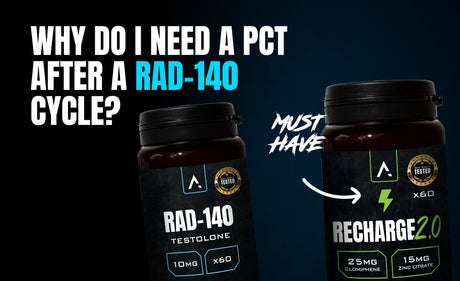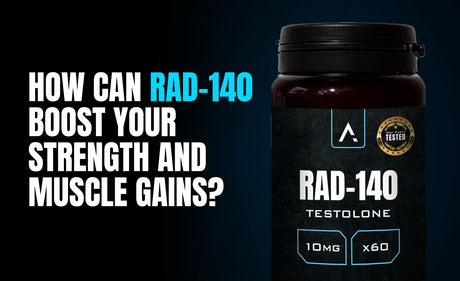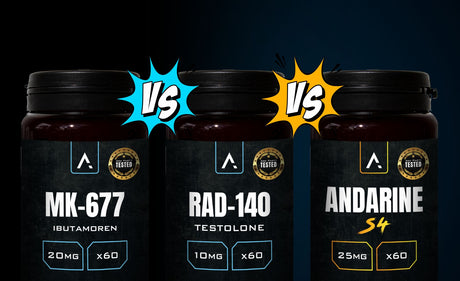RAD 140 and Endurance Sports: Improving Stamina and Performance
Endurance sports demand a high level of stamina and performance. Athletes constantly seek ways to enhance their endurance and achieve peak results. One compound that has gained attention in recent years is RAD 140. In this article, we will delve into the impact of RAD 140 on endurance athletes, exploring its effects on muscle fiber composition, oxygen utilization, mitochondrial biogenesis, lactate threshold, muscle recovery, bone density, VO2 max, and cortisol regulation. Additionally, we will discuss proper RAD 140 supplementation protocols to optimize endurance gains.
Androgen Receptor Activation: Understanding RAD 140's Impact on Endurance Athletes
RAD 140, also known as Testolone, belongs to a class of compounds called selective androgen receptor modulators (SARMs). It binds to androgen receptors in the body, activating them in a tissue-selective manner. This activation stimulates anabolic pathways, leading to increased muscle growth, strength, and endurance.
When RAD 140 binds to androgen receptors in muscle tissue, it triggers a cascade of events that result in enhanced protein synthesis. This means that the body can build new muscle tissue at a faster rate, leading to increased muscle mass and strength. For endurance athletes, this can translate into improved performance and the ability to push through fatigue for longer periods.
One of the key advantages of RAD 140 over traditional anabolic steroids is its tissue selectivity. While anabolic steroids can have a range of effects on different organs in the body, RAD 140 specifically targets the androgen receptors in muscle and bone tissues. This means that athletes can experience the benefits of increased muscle growth and endurance without the risk of unwanted side effects on other organs, such as the liver or cardiovascular system.
Furthermore, RAD 140 has been shown to have a high affinity for androgen receptors in bone tissue. This is particularly beneficial for endurance athletes who put a significant amount of stress on their bones through repetitive impact. By activating androgen receptors in bone tissue, RAD 140 can help improve bone density and strength, reducing the risk of stress fractures and other bone-related injuries.
In addition to its anabolic effects, RAD 140 also has the potential to enhance endurance performance. By activating androgen receptors in muscle tissue, it increases the production of red blood cells, which are responsible for carrying oxygen to the muscles. This increased oxygen delivery can delay the onset of fatigue and improve an athlete's ability to sustain high-intensity exercise for longer periods.
It is important to note that while RAD 140 offers potential benefits for endurance athletes, it is still a relatively new compound and more research is needed to fully understand its long-term effects and safety profile. As with any performance-enhancing substance, it is crucial for athletes to consult with medical professionals and adhere to the rules and regulations of their respective sporting organizations.
Muscle Fiber Composition and RAD 140: Enhancing Endurance through Anabolic Pathways
Endurance athletes rely heavily on the composition of their muscle fibers. RAD 140, also known as Testolone, is a selective androgen receptor modulator (SARM) that can have a significant impact on muscle fiber composition by promoting the growth and differentiation of type I and type II muscle fibers.
Type I fibers, also known as slow-twitch fibers, are characterized by their ability to contract for longer periods of time without fatiguing. These fibers are highly efficient in utilizing oxygen and are well-suited for endurance activities such as long-distance running or cycling. On the other hand, type II fibers, also known as fast-twitch fibers, are responsible for generating quick and powerful contractions. These fibers are more suitable for activities that require short bursts of power, such as sprinting or weightlifting.
When RAD 140 is introduced into an athlete's training regimen, it can influence the muscle fiber composition in a way that enhances endurance performance. By increasing the overall proportion of type I fibers, RAD 140 allows athletes to sustain prolonged efforts for extended periods of time. This can provide a significant competitive advantage in endurance sports, where the ability to maintain a high level of performance over a long duration is crucial.
Furthermore, RAD 140 also activates type II fibers, which can further enhance an athlete's performance. By increasing the recruitment of fast-twitch fibers, RAD 140 enables athletes to generate greater power output during high-intensity activities. This dual effect on both type I and type II fibers makes RAD 140 a versatile compound that can benefit athletes in various disciplines.
It is important to note that while RAD 140 can enhance muscle fiber composition and improve endurance performance, it should be used responsibly and under the guidance of a healthcare professional. Like any performance-enhancing substance, RAD 140 carries potential risks and side effects that need to be carefully considered.
In conclusion, RAD 140 has the potential to significantly impact an athlete's muscle fiber composition, leading to improvements in both endurance and high-intensity performance. By promoting the growth and differentiation of type I and type II muscle fibers, RAD 140 can enhance an athlete's ability to sustain prolonged efforts and generate greater power output. However, it is crucial for athletes to approach the use of RAD 140 with caution and seek professional guidance to ensure safe and responsible usage.
RAD 140 and Oxygen Utilization: Optimizing Cardiovascular Performance
Oxygen utilization plays a vital role in endurance sports. RAD 140, also known as Testolone, has shown promising effects on improving cardiovascular performance by enhancing oxygen utilization. This compound belongs to a class of drugs called selective androgen receptor modulators (SARMs), which have gained popularity among athletes and bodybuilders for their potential performance-enhancing properties.
One of the key mechanisms through which RAD 140 improves cardiovascular performance is by increasing the production of red blood cells, a process known as erythropoiesis. Red blood cells are responsible for carrying oxygen from the lungs to the muscles during exercise. By increasing the number of red blood cells, RAD 140 ensures that the muscles receive an adequate supply of oxygen, which is crucial for optimal performance.
Furthermore, RAD 140 has been found to enhance the efficiency of oxygen utilization within the body. This means that the oxygen delivered to the muscles is utilized more effectively, allowing athletes to perform at higher intensities for longer durations. The improved oxygen delivery and utilization provided by RAD 140 can significantly delay the onset of fatigue, enabling athletes to push their limits and achieve new levels of endurance.
In addition to its effects on oxygen utilization, RAD 140 also exhibits anabolic properties, meaning it promotes muscle growth and strength gains. This can further contribute to improved cardiovascular performance, as stronger muscles can generate more force and sustain higher workloads during endurance activities.
It is important to note that while RAD 140 may offer potential benefits for athletes and fitness enthusiasts, its use is currently prohibited in most competitive sports due to its classification as a performance-enhancing drug. Athletes should always abide by the rules and regulations set forth by their respective sporting organizations.
In conclusion, RAD 140 has shown promising effects on optimizing cardiovascular performance by enhancing oxygen utilization. Through its ability to increase red blood cell production and improve the efficiency of oxygen utilization, RAD 140 can enhance stamina and endurance, allowing athletes to perform at their best for longer periods. However, it is essential to prioritize the health and safety of athletes and ensure compliance with anti-doping regulations.
Mitochondrial Biogenesis and RAD 140: Boosting Energy Production for Endurance Sports
Mitochondria, often referred to as the powerhouse of the cell, play a crucial role in energy production. These tiny organelles are responsible for converting nutrients into adenosine triphosphate (ATP), the molecule that fuels cellular activities. Without mitochondria, our cells would not be able to generate the energy necessary for survival.
RAD 140, a selective androgen receptor modulator (SARM), has gained attention in the world of sports and fitness due to its potential to enhance mitochondrial biogenesis. Mitochondrial biogenesis refers to the process of creating new mitochondria within cells. By increasing the number of mitochondria, RAD 140 can significantly boost energy production and improve endurance.
When athletes use RAD 140, they experience a remarkable increase in mitochondrial biogenesis. This means that their cells are equipped with more mitochondria, leading to a higher energy output. With enhanced energy production, athletes can perform at their best for longer durations, allowing them to surpass their previous limits and achieve new milestones.
Imagine a long-distance runner who has been training for months to improve their performance in a marathon. They have put in countless hours of hard work, pushing their body to its limits. However, despite their dedication, they still struggle to maintain peak performance for extended periods.
Introduce RAD 140 into the equation, and everything changes. With the ability to stimulate mitochondrial biogenesis, RAD 140 provides the runner with a significant advantage. As the runner takes RAD 140, their cells start producing more mitochondria, resulting in a substantial increase in energy production.
With this newfound energy, the runner can sustain a faster pace for a more extended period. They no longer experience the same level of fatigue that used to hinder their performance. Instead, they feel a surge of energy coursing through their veins, propelling them forward with each stride.
As the runner continues to train and compete, their endurance levels skyrocket. They can now maintain their peak performance for hours on end, pushing their body to new limits. Whether it's a marathon, a triathlon, or any other endurance sport, RAD 140 proves to be a game-changer.
It's important to note that while RAD 140 offers significant benefits in terms of energy production and endurance, it should be used responsibly and under the guidance of a healthcare professional. Like any performance-enhancing substance, RAD 140 should be approached with caution, ensuring that it is used within the boundaries of fair play and ethical sportsmanship.
In conclusion, RAD 140's ability to increase mitochondrial biogenesis opens up new possibilities for athletes in the realm of endurance sports. By boosting energy production, RAD 140 allows athletes to perform at their best for longer durations, surpassing their previous limits and achieving new milestones. However, it is crucial to prioritize responsible use and adhere to the rules and regulations of the sporting community.
Lactate Threshold and RAD 140: Delaying Fatigue in Endurance Athletes
Lactate threshold refers to the point at which lactate production exceeds the body's ability to remove it. When lactate builds up, fatigue sets in, hampering an athlete's performance. RAD 140, also known as Testolone, has gained attention for its potential to increase lactate threshold and enhance endurance performance.
Endurance athletes push their bodies to the limit, constantly seeking ways to improve their performance. RAD 140 has emerged as a promising compound that may help athletes achieve their goals. Studies have shown that RAD 140 can delay the onset of fatigue, allowing athletes to perform at higher intensities for longer periods of time.
One of the key mechanisms by which RAD 140 enhances endurance is by increasing the production of red blood cells. Red blood cells are responsible for carrying oxygen to the muscles, and a higher concentration of red blood cells means more oxygen delivery. This increased oxygen supply can delay the accumulation of lactate and prolong the time to fatigue.
In addition to its effects on red blood cell production, RAD 140 also enhances mitochondrial function. Mitochondria are the powerhouses of the cells, responsible for generating energy. By improving mitochondrial function, RAD 140 can enhance the efficiency of energy production, allowing athletes to sustain their efforts for longer durations.
Furthermore, RAD 140 has been shown to promote muscle growth and strength gains. This can be particularly beneficial for endurance athletes, as stronger muscles can better withstand the demands of prolonged exercise. By increasing muscle strength, RAD 140 can help athletes maintain their performance levels even as fatigue sets in.
By delaying the onset of fatigue, RAD 140 enables endurance athletes to push their limits and sustain their efforts for longer durations without sacrificing performance. This can be a significant advantage in competitive settings where every second counts. However, it is important to note that RAD 140 is a selective androgen receptor modulator (SARM) and its use should be approached with caution and under the guidance of a healthcare professional.
RAD 140 and Muscle Recovery: Speeding Up Healing for Consistent Performance
Endurance training takes a toll on the body, leading to muscle damage and soreness. This can hinder an athlete's ability to perform at their best and impede their progress towards their goals. However, there is a potential solution that can expedite muscle recovery and ensure athletes can maintain consistent performance throughout their training and competition schedules - RAD 140.
RAD 140, also known as Testolone, is a selective androgen receptor modulator (SARM) that has gained popularity among athletes and bodybuilders for its potential benefits in muscle recovery. By targeting specific androgen receptors in the body, RAD 140 has been found to promote muscle repair and minimize the time needed for recovery.
When athletes engage in intense training sessions or competitions, their muscles undergo micro-tears and experience inflammation. This is a natural response to the stress placed on the muscles, but it can also lead to discomfort, pain, and a decrease in performance. RAD 140 works by binding to androgen receptors in muscle and bone tissues, stimulating anabolic activity and promoting the growth and repair of muscle fibers.
By accelerating the healing process, RAD 140 allows athletes to bounce back quickly from intense training sessions or competitions. This means they can get back to their training routine sooner and maintain a higher training volume, leading to continued improvements in endurance and performance.
In addition to its potential benefits in muscle recovery, RAD 140 has also been shown to increase lean muscle mass and strength. This makes it an attractive option for athletes looking to enhance their physical performance and achieve their goals.
It's important to note that while RAD 140 shows promise in promoting muscle recovery and performance, it is still a relatively new compound and more research is needed to fully understand its long-term effects and potential side effects. As with any supplement or performance-enhancing substance, it is crucial to consult with a healthcare professional before using RAD 140 or any other SARM.
In conclusion, RAD 140 has the potential to expedite muscle recovery, ensuring athletes can maintain consistent performance throughout their training and competition schedules. By promoting muscle repair and minimizing the time needed for recovery, RAD 140 allows athletes to bounce back quickly from intense training sessions or competitions. This enables them to maintain a higher training volume, leading to continued improvements in endurance and performance. However, further research is needed to fully understand the effects and potential risks associated with RAD 140.
Bone Density and RAD 140: Ensuring Endurance Athletes' Skeletal Health
Endurance athletes must also pay attention to their skeletal health. The repetitive impact and stress placed on bones can lead to the risk of fractures and decreased bone density. RAD 140, also known as Testolone, has shown potential in improving bone mineral density by stimulating bone formation.
When it comes to endurance sports, the skeletal system plays a crucial role in supporting the body's movements and absorbing the impact of repetitive motions. Whether it's running, cycling, or swimming, the constant pounding on the bones can take a toll over time. This is why maintaining optimal bone health is essential for athletes who engage in endurance activities.
RAD 140, a selective androgen receptor modulator (SARM), has gained attention in recent years for its potential benefits in enhancing bone health. Studies have shown that RAD 140 can increase bone mineral density by stimulating the activity of osteoblasts, the cells responsible for bone formation. By promoting bone growth, RAD 140 helps athletes maintain strong and resilient skeletal structures.
But how exactly does RAD 140 improve bone density? The answer lies in its interaction with androgen receptors in the body. Androgens are hormones that play a crucial role in regulating bone metabolism. By binding to androgen receptors, RAD 140 activates specific signaling pathways that promote bone formation and inhibit bone resorption.
Furthermore, RAD 140 has been found to have an anabolic effect on skeletal muscle tissue. This means that it can help athletes not only improve their bone health but also enhance their muscle strength and endurance. By increasing muscle mass, RAD 140 indirectly contributes to better bone health by exerting more mechanical stress on the bones during exercise, which in turn stimulates bone remodeling and adaptation.
By ensuring optimal bone health, RAD 140 contributes to the overall well-being of endurance athletes. Stronger bones can better handle the demands of endurance sports, reducing the risk of stress fractures and other skeletal injuries. Additionally, improved bone density can also have long-term benefits, as it helps protect against age-related bone loss and conditions such as osteoporosis.
It is important to note that while RAD 140 shows promise in improving bone health, further research is still needed to fully understand its long-term effects and potential side effects. As with any performance-enhancing substance, athletes should consult with healthcare professionals and adhere to appropriate dosage guidelines to ensure safe and responsible use.
RAD 140 and VO2 Max: Maximizing Oxygen Uptake for Endurance Enhancement
VO2 max, a measure of the body's maximal oxygen uptake, is a crucial indicator of an athlete's cardiovascular fitness. RAD 140 has been reported to increase VO2 max in endurance athletes, leading to enhanced oxygen uptake and utilization during exercise.
Through increased VO2 max, RAD 140 helps athletes perform at higher intensities for longer durations, enabling them to cover more ground in the same timeframe. This benefit translates directly into improvements in endurance and overall performance.
Cortisol Regulation and RAD 140: Managing Stress Hormones in Endurance Sports
Stress hormones, such as cortisol, can have detrimental effects on endurance athletes. RAD 140 has been studied for its potential in regulating cortisol levels, reducing the negative impact of stress on the body.
By managing cortisol levels, RAD 140 helps athletes maintain an optimal hormonal balance, preserving muscle mass, reducing fatigue, and promoting recovery. This ultimately contributes to improved endurance and consistent performance.
RAD 140 Supplementation Protocols: Dosage and Timing for Optimal Endurance Gains
When considering RAD 140 supplementation, it is crucial to follow proper dosage and timing protocols. While individual needs may vary, general guidelines suggest starting with a lower dosage and gradually increasing it over time.
Consulting with a knowledgeable healthcare professional is advised to determine the appropriate dosage range and cycling strategies based on an athlete's goals and unique circumstances. Additionally, proper post-cycle therapy should be implemented to ensure a safe and effective RAD 140 experience.
In conclusion, RAD 140 holds significant potential for improving stamina and performance in endurance sports. Through its effects on muscle fiber composition, oxygen utilization, mitochondrial biogenesis, lactate threshold, muscle recovery, bone density, VO2 max, and cortisol regulation, RAD 140 offers endurance athletes valuable tools to push their limits and achieve peak results. However, it is vital to approach RAD 140 supplementation with caution and under the guidance of medical professionals. With the right protocols in place, RAD 140 can unlock new levels of endurance and performance for dedicated athletes seeking to reach their full potential.
Elevate your athletic performance and boost your endurance with our RAD 140 supplement. Recognized as one of the most potent SARMs for building muscle and increasing endurance, RAD 140 can help you achieve rapid gains in the gym, enhance stamina, and support both bulking and cutting. Whether you're an athlete, a bodybuilder, or simply someone aiming to improve their fitness, RAD 140 could be your key to unlocking new levels of performance.
Take the leap towards improved stamina and endurance by purchasing RAD 140 at APH Science RAD 140.










